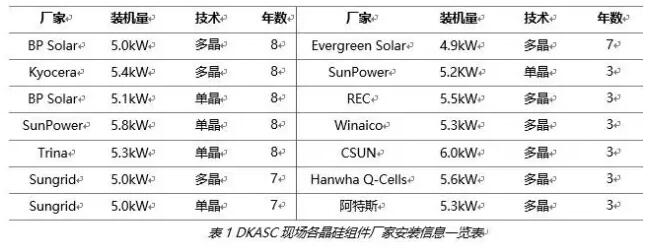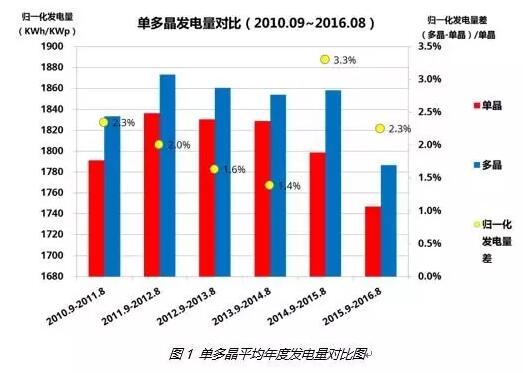Since 2008, a total of 24 component manufacturing companies worldwide have voluntarily sent their component systems to the DKASC platform for testing, including Artes, Trina and CLP PV from China. At present, DKASC has a total of 42 power station systems, including 25 polycrystalline systems, 9 single crystal systems, and others are various thin film battery systems. The longest power station system has been in operation for eight years.
The system installation information of the mainstream crystal silicon manufacturers of the DKASC platform is as follows (years 3-8 years)


Comparison of power generation of polycrystalline and monocrystalline modules in the same manufacturer In order to eliminate the influence of process levels between different companies and the selection of component packaging materials on the power generation of components, we selected two more sets of BP Solar installed in May 2009. The crystal and single crystal 5KW systems, as well as the two sets of polycrystalline and single crystal 5KW systems installed by Sungrid in May 2010, compare the power generation, as shown in Figures 2 and 3.


Surprisingly, photovoltaic academia generally believes that the 'initial photoinduced attenuation' of a single crystal is 1% to 1.5% higher than polycrystalline. If the single crystal is 1% - 1.5% less than the polycrystal, the amount of electricity generated can be explained. However, data from field power plants show that the actual power generation of single crystals is much smaller than that of polycrystalline components ("1%-1.5%"). This phenomenon has also been reproduced in several domestic power plants with single and polycrystalline components installed in the same location.
Is there any other mechanism that we do not understand about the small amount of single crystal power generation?
There is a possibility that the light decay of the single crystal cell is not only large but also uneven, resulting in mismatch in the photovoltaic cell assembly and in the photovoltaic power plant string and array, thereby further reducing the power generation of the single crystal photovoltaic system.
Another possibility is that the initial photoattenuation can't be recovered in as long as 6-8 years.
We welcome colleagues in the photovoltaic industry to provide more field measurements. In order to avoid 'self-talking', scientific and reliable data should meet the following conditions,
* Same installation conditions and location * Fair, open, verifiable data from third-party independent agencies * Long enough system operation time
Summary and recommendations:
1. From the perspective of normalized power generation from different manufacturers, polycrystalline PV modules are 2.2% higher than single crystals.
2. From the same manufacturer's normalized power generation, polycrystalline PV modules are 2.9% higher (Sungrid) and 2.4% (BP Solar), respectively.
3. Higher initial photoinduced attenuation (LID) may be the main cause of low single crystal photovoltaic power generation, and there may be other mechanisms that cannot be recovered in six to eight years.
4. The PV industry should immediately introduce new standards to tighten the oxygen content of silicon wafers and the 'initial photoattenuation' of the cells and components, namely Light Induced Degradation (LID).
The light source (which is often also called a fiber optic projector or fibre optic illuminator) provides the illumination to any fibre optic lighting system. They contain the lamp or LED and any additional control gear to provide special lighting effects.
Light sources are the only part of a fibre optic system which contains electricity, and they are the only part that, depending on the type, can get warm to the touch.
Illuminators,Fibre Optic Illuminator,Led Fiber Optic Lights,Fiber Optic Illuminator,Fiber Optic Projector
Jiangxi Daishing POF Co.,Ltd , https://www.opticfibrelight.com